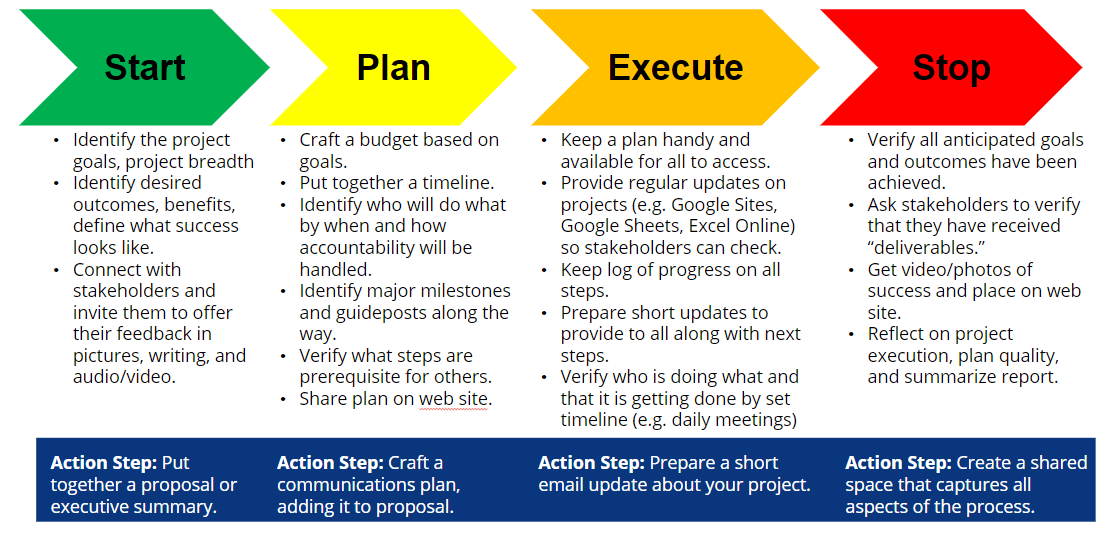Ever find yourself in charge of a project? Whether it’s your first time out, or even if you are a veteran, project management can be tough. You may think you know what your next steps are, but then all sorts of problems arise. In this blog entry, let’s explore some project management fundamentals.
“Houston, We Have a Problem”
“Our kiddoes are stuck in a portable building with NO internet access,” challenged a kindly, experienced principal. She smiled. I smiled. She continued. “Why don’t my kids have internet access? Why can’t my teachers fill out digital attendance or grades? I’m not sure why. Can you help me, please?”
This was, as you might imagine, the beginning of a fun project. What would you do to get this working? My first steps were to find out who the stakeholders were and who had started work (and left it unfinished). It was also to assume ownership of the project. The project? “Connecting 4th Grade Portable 6 to the District Network.”
Check out Venngage’s The 4 Stages of the Project Life Cycle. The project life cycle is a 4-step framework designed to help project managers guide their projects successfully from start to finish.
In any place, there are ways to get jobs done. In some locales, a conversation suffices to move those involved towards action. In others, only a formal presentation or proposal will work. Let’s dig deeper into project management fundamentals.
Defining Project Management
Project management involves applying processes, knowledge, skills, and experience. You use whatever you have to achieve a project’s stated objectives. Several factors play into project management, such as time, the scope of the project, and cost.
If a problem is not resolvable in one, quick step, then you have the potential for project management. In fact, it is best to break down how to resolve a project into manageable steps.
Did You Know?
Learn more about project management via the TCEA IT/Director certification course. As a technology system admin, coordinator or director, you will need to organize and coordinate large projects that may become quite detailed. This session in the certification course will introduce you to the fundamentals of organizing such projects while highlighting tips and best practices.
Project Management Action Steps
As a veteran project manager in K-12 school settings, I use the following steps. You may recognize them with a few slight modifications.

Let’s explore these steps in the context of a real-life problem I encountered in a middle school:
“When the power poles in the computer labs were put in, the maintenance department failed to connect the power.”
“Wait,” I asked in surprise, “Are you saying that all these power poles do not have power in them? Are you just daisy chaining the power from one outlet?”
“Yes,” replied the media specialist. “That is exactly what we have had to do. As you can guess, we can’t put as many computers in this room as we would like. And I’m worried about overloading power. Isn’t this unsafe or something? I’ve told my principal, but she doesn’t have the money to get it done and it should have been done when they built the school several years ago.”
What a delightful problem! To address this, and follow the steps, I put together the following:
Step 1 – Start
 Identify the project goals and scope, define success, and connect with stakeholders. To achieve this, I put together an executive summary. You can read about various proposal forms and executive summaries in my series. The three-part series, Solving Wicked Problems: Talk is Cheap, serves as a nice primer. In the executive summary, I provide these elements with more questions:
Identify the project goals and scope, define success, and connect with stakeholders. To achieve this, I put together an executive summary. You can read about various proposal forms and executive summaries in my series. The three-part series, Solving Wicked Problems: Talk is Cheap, serves as a nice primer. In the executive summary, I provide these elements with more questions:
- Overview (with details and locations)
- Staff Impact
- Student Impact
- Budget Available
- Professional Learning
- Products
- Stakeholders Affected
I provide my best responses to these questions:
- Why is this necessary?
- What happens if we don’t implement?
- How will we measure success?
- When will this happen?
This is often a one-page document that anyone can read and take action on. In this case, I had the campus media specialist and principal review it. Then, I submitted it on their behalf to the Superintendent’s Cabinet for disposition.
Step 2 – Plan
In this step, craft a budget, a timeline, and determine who will do what by when; that last piece is critical. You will include all these details in your executive summary. One key aspect of this step that often goes unnoticed is the communications plan. Make sure that you craft a communications plan that includes how you are going to share the latest status reports.
When preparing a communications plan, I include a website address. This website is an online document or web page with all the details. It takes ten minutes to set up and less to update. In this situation, a Google Sites page was set up and regular updates provide there. My goal? To ensure that if anyone had a question about how money was being spent, they could find it themselves. No need to call me or interrupt technicians working on other projects.
To be clear, documenting status in a work order system only goes so far. A communication plan includes different types of updates for all stakeholders. Those updates can be the website but also emails, a two-minute phone call, or a face-to-face chat.
Step 3 – Execute
Ready to execute your plan? Make sure to log all progress, providing short updates to stakeholders. Just as important is that you verify who is doing what and that it is getting done in alignment to the timeline. You may need to put into place some daily check-in meetings a la Patrick Lencioni.
Step 4 – Stop
Before you declare success on any project, ask stakeholders. Ask them to verify if they have received the “deliverables” they identified and thought they would receive. You can preempt some of this. Get video/photos of success and put them on your project website. Verify achievement of articulated goals and outcomes. Did you have to do something extra? Then make sure to mention that.
One way to flush out these insights involves reflecting as a team. Bring everyone together to reflect on project execution and plan quality. Write those reflections as a short report and then put them on the project website.
Project Management Done Right
“Did you get this done right?” your superintendent or supervisor will ask. After you say “Yes!” show them your documentation, the videos, or artifacts of observed success. They may not want to see it at first, but there is more to it than that. It’s about building their trust in you to get things done. It’s also about training them to go online to see how things are progressing in any given project. Wouldn’t you rather spend your time getting things done than sitting in a meeting?

